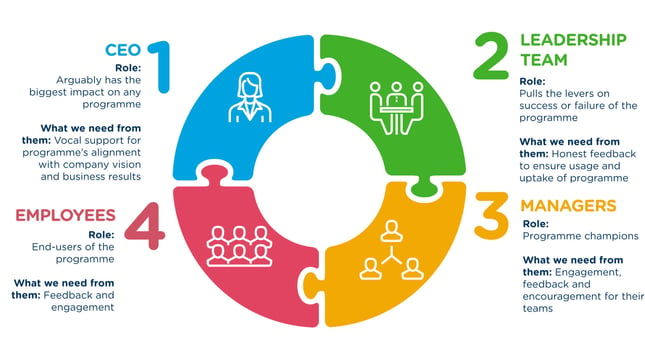Employee engagement – the outcome of engaged employees is clear, better business outcomes in the form of revenues, profits, and growth. So just how do you get your business to undertake this strategy and who should own it?
Firstly, I think the case for having an engagement strategy is clear, and if you are not convinced then you need to read this and this.
But that’s just the first step. As I’ve talked about before when referencing my own People Team strategy, it’s hard to reach specific goals unless it has a clear owner.
So who actually owns employee engagement?
There is no wrong answer, there is no right answer, but what is best for your business. But we know that in broad terms there are four parts of the business which need to be included in the thinking here:
- CEO
- Leadership team
- Managers
- Employees
These layers, or levels, are not singular or unrelated, they are conjoined and overlapping, they are concurrent and consecutive, they should be aligned and they should be working together for outcomes that benefits each and every one of them.

So let us start by looking at what each brings to the table:
The CEO: The leader of the business, the figurehead, the person with the single biggest impact on any programme, especially the employee engagement one. We need them to lead and support what is being delivered, but we also need their honest voice to make sure it aligns to their vision for the business.
We need them to ensure what the employee engagement programme is delivering the business results that will mean the business hits its objectives.
Leadership: Collectively they run the business day to day, they pull the levers, they have sphere of control that decides whether the programme works or fails in their areas. To make this work you need to ensure that the programme matches their needs, but also aligns to their objectives, you need their input on the nuances of what is needed in their areas, you need their thoughts and feedback on what you are trying to do.
The Leadership team can also be your secret weapon, as well as having a vested interest in what you are trying to achieve, they will be able to help you with different aspects of projects and programmes and the strategy. They will be able to help you and guide you, they will have the influence to make it a success.
Engaging with them will be the difference between success and failure for you in many cases.
.jpg?width=500&name=Reward%20Gateway%20In%20Action-9345%20(1).jpg)
Managers, perhaps the most obvious part of the process. You need them to align to what you want to do, you need them to be bought in to what you are doing and you need them to run initiatives in their local teams, to feedback, to help share and shape what you are doing and you need them to be the soldiers in the army of success in what you are trying to achieve.
Last but by no means least, employees. If you really want engagement to work, and work well, you need to engage your employees, no pun intended. You need to get their feedback on what you are doing, get their help with programmes, get them to what you are doing, feedback on this and in many cases be the champions of it all.
We need to envision this as being a circle with four equal points, that covers each aspect, without one working and contributing you cannot make it as effective as you wish.
Employee engagement is a team effort
The reality is that while you may want someone to be in charge of engagement, you cannot make a single person accountable. You can and should have someone who has the responsibility for the execution of your actual employee engagement software, but the complex nature of engagement, the wide range of data, requirements, delivery and support needed, means that each of the four layers above are of equal importance, and contribute equally to the success of increasing the engagement of your employees.
- Without CEO sponsorship and support the chances are the programme will not embed deep enough into the company.
- Without the Leadership team ensuring global alignment and local support across the teams you will end up with uneven delivery and success.
- Without manager buy-in you will not have partners to work with you on making everyone aware of the programme and having it delivered at a local level.
- And without employees being engaged with the programme you will not engage them with the business.
It’s time to think of employee engagement as being a part of everyone’s goals, not just HR. The success of the employee engagement initiatives put in place can only grow as big as the understanding of its impact across the wider business.

 Robert Hicks
Robert Hicks

